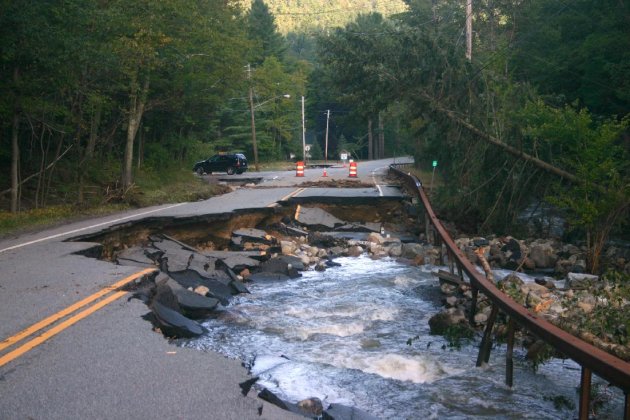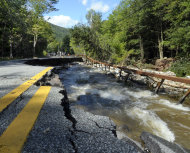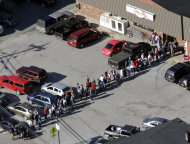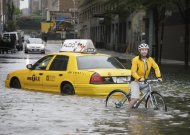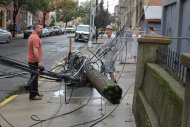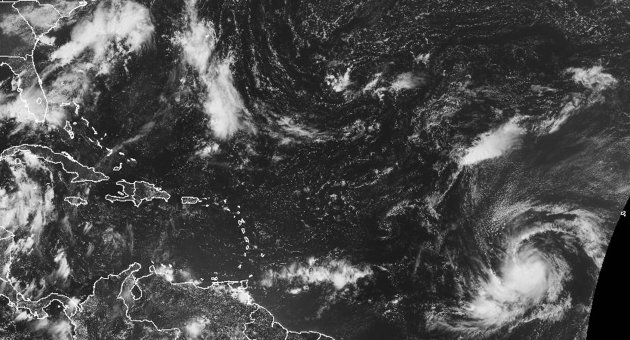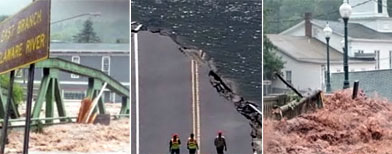Irene, the hurricane that weakened to a tropical storm, thrashed the East Coast, knocking out power to millions of homes and businesses, destroying piers and killing at least 38 people in 11 states. Here's a state-by-state glance on how it's affected states along the Eastern seaboard:
CONNECTICUT
__ The storm hit Connecticut on Sunday with 60 mph winds and drenching rain, destroying dozens of homes along the shoreline.
__ More than 674,000 utility customers still were without electricity Monday afternoon. At the peak out of the outages Sunday, about 775,000 customers were without electricity.
__ Connecticut tax officials are extending some business tax filing deadlines by a week — from Aug. 31 to Sept. 7 — because of Tropical Storm Irene.
DELAWARE
__ Two men who decided to sprint through hurricane at peak of the storm were found dead Monday in a waterway in a northern town.
__ About 7,600 homes and businesses without power as of late Monday afternoon.
__ Apparent tornado damages 15 structures near Lewes. No injuries reported.
__ Residents of a small coastal community were left isolated from their homes after an access road through Prime Hook National Wildlife Refuge in southern Delaware was washed out.
__ Governor says worst of Irene passed Sunday; he went on a helicopter tour of affected areas.
__ 16,000 chickens died when a Kent County poultry house was flooded during the storm.
FLORIDA
__ Hurricane kicked up heavy waves killing a 55-year-old surfer; a New Jersey tourist, also died in rough surf.
MAINE
__ Wind, heavy rains reached the state Sunday; the wind died down ended Monday.
__ More than 300,000 customers were without power at some point during storm; around 190,000 outages remained Monday afternoon.
__ Winds reached 49 mph on land, 8-9 inches of rain in western areas of state resulting in flash floods.
__ 200 roads and 12 bridges closed by floods or fallen trees.
__ Gov. Paul LePage toured Carrabassett Valley and Rumford areas of western Maine by helicopter to survey highway and bridge damage.
MARYLAND
Gov. Martin O'Malley says about 443,000 electricity customers remained without power Monday afternoon.
__ Up to 12 inches of rain fell on Ocean City.
__ Maryland Transit Administration restored service Sunday after suspending it.
MASSACHUSETTS
__ Rivers that overflowed their banks in Massachusetts because of Tropical Storm Irene washed out roads, swamped cornfields and dislodged a covered bridge.
__ More than 400,000 customers in the state remained without electricity at midday Monday.
__ Public transportation in Boston reopened Monday morning after being shut down for most of the day Sunday. Logan International Airport is also back to normal.
__ Gov. Deval Patrick toured hard-hit areas Monday by ground and air.
NEW HAMPSHIRE
__ Drenching rain and high winds reached state Sunday afternoon.
__ 175,000 homes and businesses were without power at the peak of the storm, 113,000 outages by Monday.
__ 200 local roads and 42 state roads closed from flooding and downed trees.
__ 250 people used nearly two dozen shelters, which had a capacity of 4,000 people.
NEW JERSEY
__ Irene hit at Little Egg Inlet north of Atlantic City early Sunday, only the third to make landfall in the state in the last 200 years.
__ About 600,000 homes and businesses were without power Monday afternoon, down from over 900,000.
__ Atlantic City casinos resume operations after rare shutdown.
__ Floodwaters remained on tracks in Trenton, N.J. on Monday, preventing Amtrak service between Boston and Philadelphia.
__Beaches on state's longest barrier island, Long Beach island, found to have lost 4 to 5 feet of height and up to 150 feet of width.
NEW YORK
__ Irene made landfall Sunday near Coney Island in New York City.
__ Massive rains upstate swelled waterways, shredding roads, knocking out bridges and tearing buildings off foundations in several counties.
__ Officials rescued 191 people.
__ At its peak, 945,000 homes and businesses statewide lost power, about half on Long Island. By Monday afternoon, 808,000 were still without power.
__ New York's major airports reopened Monday.
__ New York City's public transit system, the nation's biggest, was shut down until at least Monday.
__ Some traders at the New York Stock Exchange slept above the trading floor to be there for Monday's opening bell. It rang on time at exactly 9:30.
NORTH CAROLINA
__ The storm that made landfall at Cape Lookout on Saturday and then steamed up the East Coast.
__ Overall there were about 239,000 outages across eastern North Carolina late Monday.
__Local officials reported a 13-foot surge from Pamlico Sound into Beaufort County.
__ Nearly 1,900 prisoners evacuated from three coastal prisons.
__ Gov. Beverly Perdue and other officials offered assurance that the state's beaches, North Carolina's top tourism destination, are ready for Labor Day.
PENNSYLVANIA
__ Fears of flooding by the Delaware River in eastern Pennsylvania after it crested at just more than 25 feet and stayed within its banks.
__ The number of customers without power fell to 443,000 Monday from 706,000 the day before
__ Public transit in Philadelphia was up and running, save for a few regional trains.
RHODE ISLAND
__ Irene made landfall Sunday as a tropical storm.
__ As many as 340,000 of the state's electrical customers lost power after Irene. The number was down to 276,328 Monday evening.
__ Rhode Island health officials issued a boil-water advisory for about 1,000 residents statewide after several water systems lost pressure due to electricity outages caused by Irene.
SOUTH CAROLINA
__ Beach erosion reported at high tide Friday evening on Edisto Island and Folly Beach.
__ About 5,000 customers lost power from storms in Irene's outer bands.
__ Irene moved away from the state Saturday morning.
VERMONT
__ Gov. Peter Shumlin says flooding from Irene is the worst in the state in a century.
— Whole communities are cut off, almost 50,000 customers are without power, and hundreds of roads are closed.
__ At least a dozen bridges have washed away.
__ The Vermont State Hospital was evacuated after flood waters threatened the facility in Waterbury.
VIRGINIA
__ The storm battered two-thirds of Virginia during its weekend assault on the region.
__ About 514,320 customers remained without power Monday afternoon, most in the Richmond area.
__ Suffolk received 11 inches of rain, and other localities east of Interstate 95 received about 5-10 inches.
__ Hampton Roads area saw near-record storm surge that could lead to flooding. Gov. Bob McDonnell and other officials took an aerial tour of the area.
WASHINGTON, D.C.
__ About 7,700 homes and businesses without power.
__ About 200 trees were down around the city.
__ Washington National Cathedral officials say Hurricane Irene has not worsened any damage from last week's earthquake that caused significant damage at the church.
__ Approach of hurricane forced postponement of Sunday's dedication of Martin Luther King Jr. Memorial.
__ Public transit in nation's capital never shut down.
http://news.yahoo.com/state-state-look-irene-dangers-damage-184054882.html
